It’s always an event when Apple launches a MacBook, both literally and figuratively. This year though MacBook Pro fans will have to settle for an internal spec improvement rather than radical design overhaul.
As has been the case since Apple ditched the 17-inch MacBook Pro back in 2012, there are two sizes of MacBook Pro in the 13-inch and the 15-inch models. As we said in our preview of the 13-inch MacBook Pro, the 15-inch model is more deserving of the name "Pro" than it"s smaller sibling. However, is it truly a pro machine?
The Pro status of Apple’s 15-inch MacBook depends on what sort of ‘pro’ you are. Traditionally creative pros would have turned to the Mac for their needs, be it design work, editing photos, working with video and animation, or other jobs that require decent graphic capabilities.
Other MacBook Pro users might include gamers, programmers, and office workers who need a capable Mac with a larger screen than the 13-inches offered by the other Mac laptops.
We will be considering all these users as we evaluate the 2017 15-inch MacBook Pro. Is the new MacBook Pro going to answer their requirements or would they be better off with a different Mac, or dare we say, a PC or Linux machine.
The two changes to the MacBook Pro models launched at WWDC in June 2017 are the Kaby Lake processors and the improved graphics. Do those updates combine to make this a five star machine?
You can also read our comparison of all the "pro" Macs here, find out which is the best Mac for pros, and we also have a comparison of the two MacBook Pro models here.
Price and availability
The MacBook Pro remains an expensive computer:
- 2.8GHz Kaby Lake i7 quad-core processor, Touch Bar, 16GB RAM, 256GB storage, Radeon Pro 555, £2,349/$2,399
- 2.9GHz Kaby Lake i7 quad-core processor, Touch Bar, 16GB RAM, 512GB storage, Radeon Pro 560, £2,699/$2,799
Build-to-order options:
- 3.1GHz Kaby Lake i7 quad-core processor + £190/$200
- 1TB SSD + £360/$400
- 2TB SSD + £1,080/$1,200
Apple also offers the older 2015 Broadwell chip 15-inch MacBook Pro priced at £1,899/$1,999. It is now the only MacBook that Apple sells, in any line and any screen size, that has ports such as USB-A, HDMI and an SD card slot.
Design and build quality
Reservations about the price aside, this is out and out a premium laptop. For a 15-inch device it is remarkably slim, keeping an identical profile to the 2016 model. Our review unit was Space Grey, our preferred colour, but you can go for the classic MacBook silver too.
This means you are faced with a stunning Retina display with pleasingly thin bezels a full size keyboard with Apple’s improved second-generation butterfly keys and that now famous (infamous?) Touch Bar. We’ll get more into that further in.
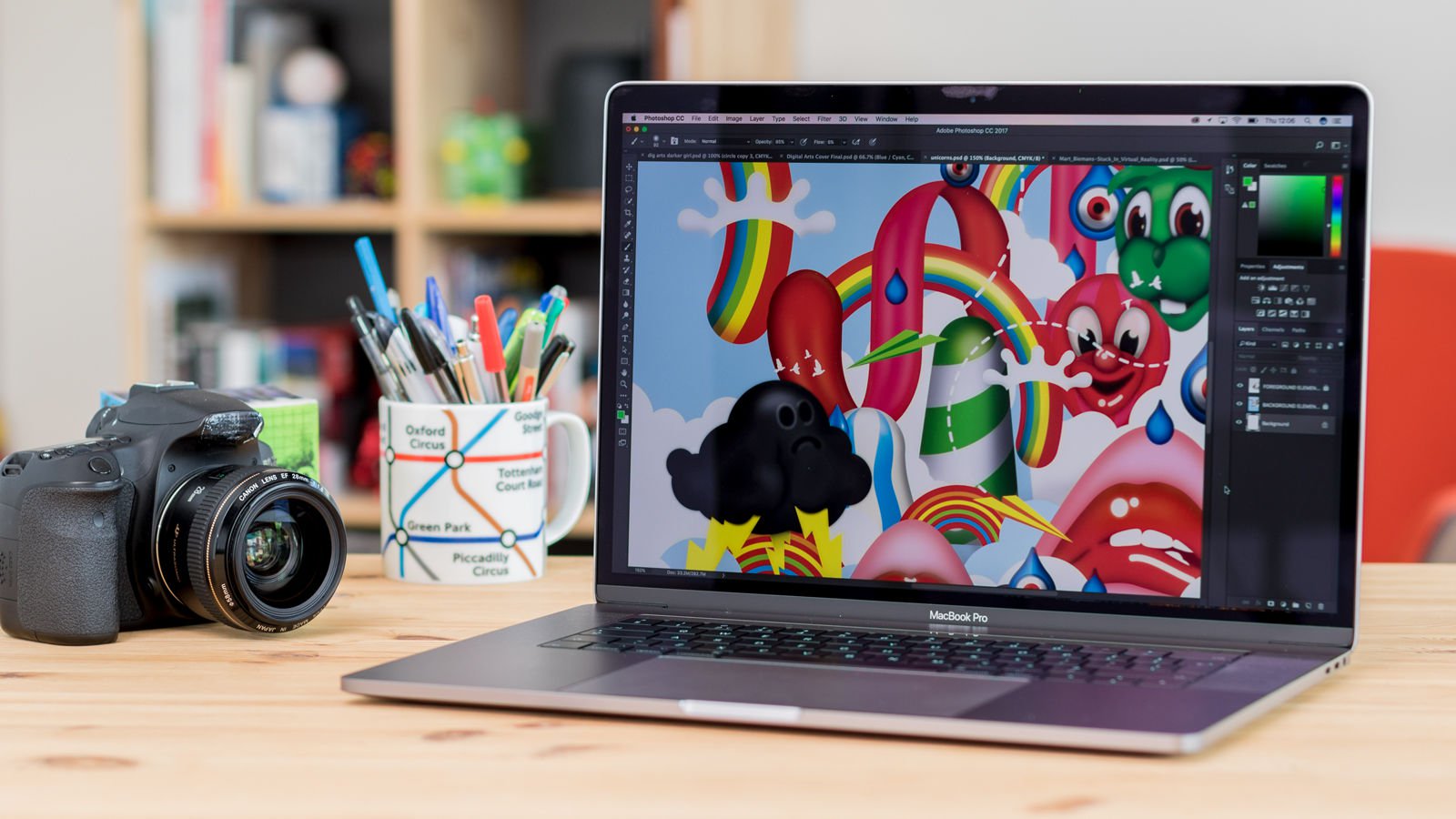
There is also a convenient Touch ID fingerprint reader worked into the Touch Bar, while the 15-inch design allows for symmetrical speaker grilles either side of the keyboard. As usual, Apple excels in its positioning of the trackpad; here it is huge but we never found our palms encroaching on it.
The Touch Bar itself remains, and it will again continue to divide opinion. From a purely design point of view, it’s great. It works well with no lag and the interface is surprisingly intuitive for such unique hardware.
At first it’s jarring, but over extended use you will start to enjoy its quirks – though if you use many programs that simply need function keys at all costs, it’s going to really annoy you.
The impressive slim form factor is largely possible thanks to Apple’s removal of some, debatably pro, ports. Long gone is the CD drive, but also carried over from last year’s model is the absence of any ports other than four USB-C (Thunderbolt 3, two on each side) and a solitary headphone jack.
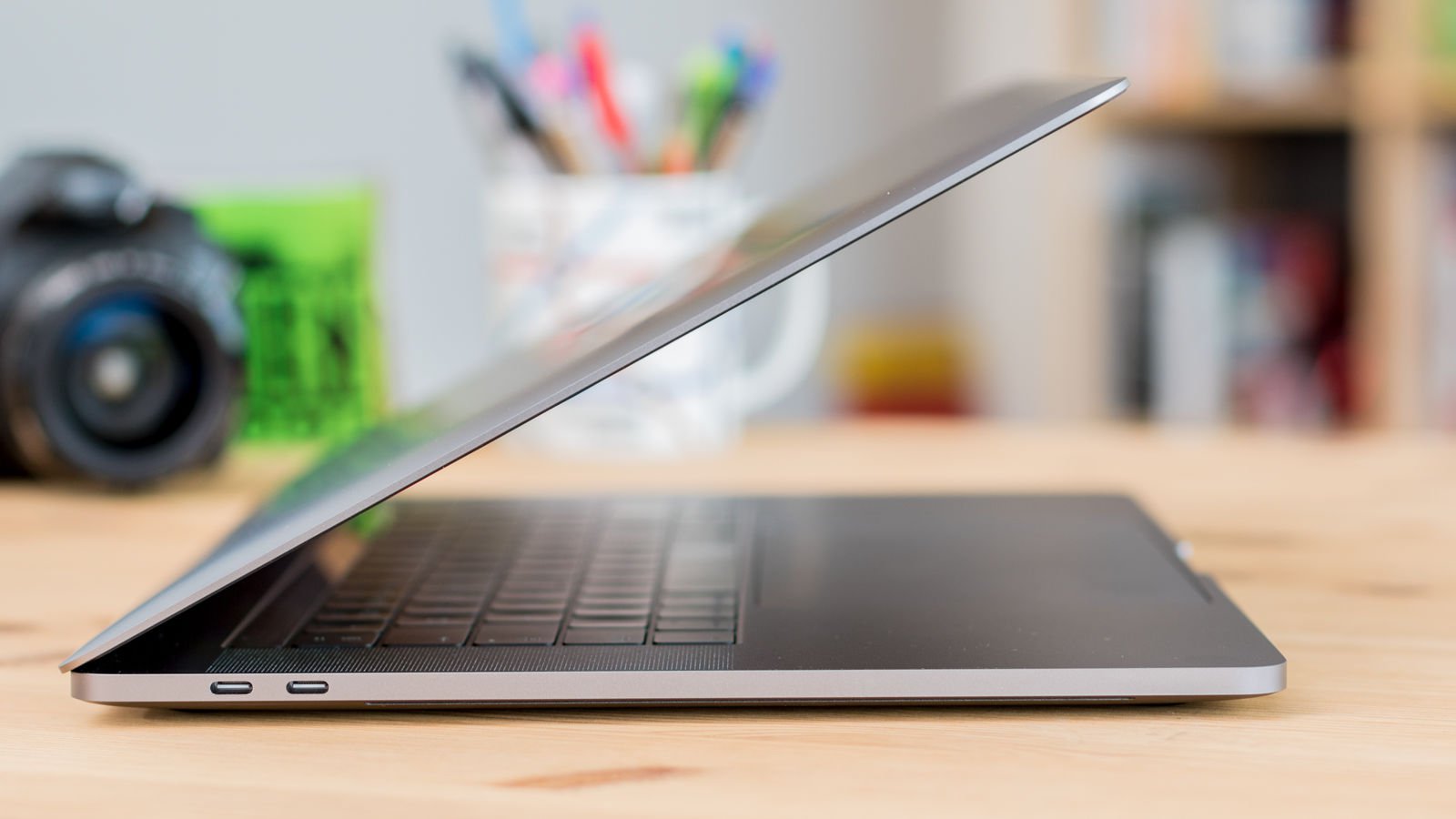
Apple’s design here is commendable in how it is instantly recognisable as a MacBook. So far down the product line, it’s still exciting to open it up out the box and still be familiar with the lineage. If this turns out to be your first MacBook though, then you will be truly spoilt by the attention to detail, from the precise cut of the chassis to the minimalist cut keys.
Features and specs
The form factor for a 15-inch machine is impressive, with the Pro measuring 34.93 x 24.07 x 1.55cm when closed. Yes, 1.55cm thick on a MacBook Pro. 2017 eh, it’s the future!
It’s 1.83kg, a weight that is well distributed. You may not want to carry it in a messenger bag but it’s certainly in the ‘portable’ bracket more than ever before.
Display
The laptop has a 15.4-inch backlit Retina display and yes, it looks amazing as we’ve come to expect from Apple. The 2880x1800 resolution is a dream no matter what you’re looking at, and is, for all day use, preferable to the 13-inch alternative.
It boasts 220 pixels per inch with an often blinding 500 nits brightness and a P3 wide colour gamut. Viewing angles are outstanding and there is zero light bleed from any corner or edge.
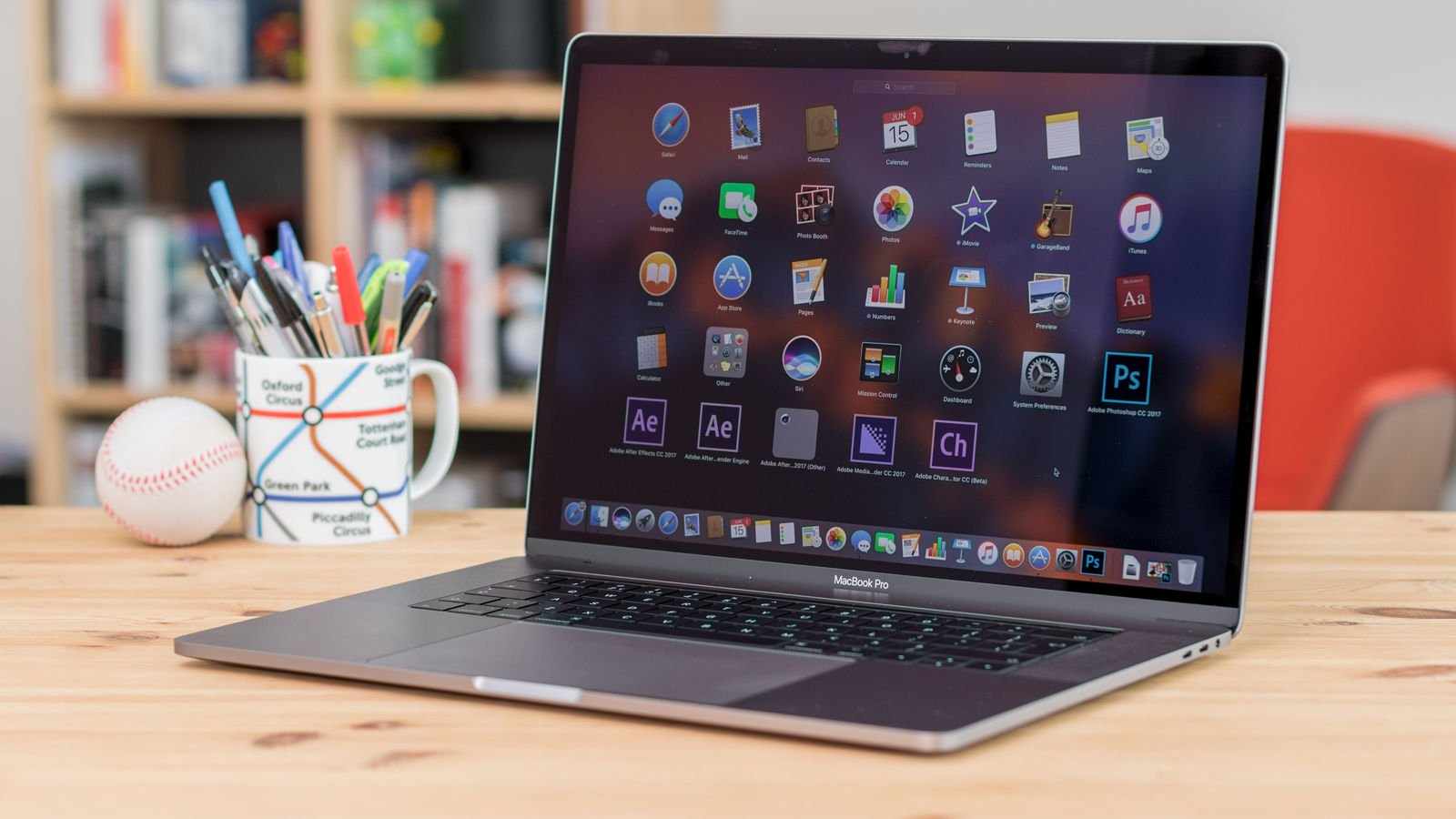
It supports several scaled resolutions up to 1920x1200, but the absence of HDMI means you’ll need the requisite adapter.
It’s worth noting that many Windows rivals now have 4K displays, something that Apple has never offered on a MacBook. Considering the high price of the 15-inch MacBook Pro, if you need a 4K display then the 21.5-inch iMac starts at £1,249.
Trackpad and keyboard
Yet with just 15 inches, multi-window use is exemplary, particularly in conjunction with the excellent trackpad, which measures a massive 159x99mm. Apple remains a class-leader in input with Force Touch, the pressure sensitive technology that allows for simulated clicks and actions using only haptic feedback under the pad.
You can, for example, press harder for a deeper click and take advantage of another function depending on the app or program you are in. It becomes second nature after a while. It’s also preferable to a mechanical trackpad because you can click anywhere on it, even at the top.
Multi-touch gestures take a while to learn and they are limited in the main OS but become useful for editing purposes in pro apps like Final Cut. Being able to apply two kinds of pressure to a trackpad has opened up a wealth of existing and future possibilities for developers too, and is a clear and well-executed advantage over PC counterparts.

Typing on the MacBook Pro is practially a desktop experience such is the quality of the set up. The 65 keys on the UK version (64 on US models) use Apple’s second generation of butterfly keys that respond excellently no matter where pressed.
They have shallower travel than all MacBook Pro models 2015 and earlier though, so you may want to test them out before taking the purchase plunge. If you’re used to that kind of travel, you’re probably still going to be frustrated at the adjustment required.
Each key is backlit with its own LED, which is pretty luxurious. The combination of expansive, responsive trackpad and high quality keyboard in a 15-inch laptop that remains extremely portable is very attractive, but be aware of the changes.
In a minor change from 2016, the control and option keys now denote keyboard shortcuts as opposed to the previous markings that helped PC users translate Mac functions.
Processor, RAM and graphics
The update for 2017 is internal. There are finally Kaby Lake processors, Intel’s seventh generation chips. They offer higher boosted clock speeds than their predecessors, and means Apple has caught up with the HP ProBook 400 range, Dell XPS 13 Touch, Acer Aspire E, and Asus ZenBook 3 that all have Kaby Lake chips.
Our review unit is the high-end 2.9GHz quad-core Intel Core i7, which can turbo boost up to 3.9GHz and has 512GB storage with 16GB of 2133MHz LPDDR3 onboard memory. This RAM tops out in the range at 16GB, but works at a higher frequency than last year’s 1,866MHz.
There are calls for Apple to offer up to 32GB RAM in the MacBook Pro, with fingers pointing to Dell’s Precision 5520 laptop, which has a 32GB RAM build-to-order configuration.
Back in November 2016 Apple"s SVP of Worldwide Marketing Phil Schiller spoke out after criticism that the MacBook Pro topped out at 16GB RAM, saying that if Apple was to offer more RAM it would be detrimental to battery life. This is because the higher amounts of RAM would require a power-hungry memory controller.

Schiller said: "To support 32GB of memory would require using DDR memory that is not low power and also require a different design of the logic board which might reduce space for batteries. Both factors would reduce battery life.”
Unfortunately even the Kaby Lake processor upgrade for the MacBook Pro could not increase the RAM cap of 16GB because the Kaby Lake processor doesn"t support LPDDR4 RAM either.
That said, 16GB RAM is a lot and will perform admirably for all but the most demanding of users. Add to it a Radeon Pro 560 GPU with 4GB of GDDR5 memory paired with Intel HD Graphics 630 and you’re fully loaded. The advantage here is a separate dedicated graphics card – on the 13-inch MacBook Pro it’s lower spec and integrated.
Bear in mind that with this much power under its hood, the MacBook Pro needs a fan, unlike the fanless 12-inch MacBook.
The stereo speakers on the MacBook Pro also delight, with a decent dynamic range and often surprisingly good bass response. The 15-inch display is great for solo movie viewing as much as it is spreadsheet crunching or video editing.
The Pro is moving the goalposts every year; it’s no longer just for professional users, which is to the annoyance of some. But the versatility of an admittedly expensive machine is preferable, particularly if you’re forking out for one to use as your main device. Just because you’re a videographer, doesn’t mean you don’t want to sit in bed and binge Netflix. You can do both with the 15-inch MacBook Pro.
The review continues on the next page.
Benchmark results and analysis
The following results show how this new model compares with the previous year’s top of the line model, the 2.7GHz 15-inch. We also have the 2.6GHz 15-inch from 2016, and the 2.9GHz 13-inch and 2.0GHz 13-inch models for comparison.
Geekbench 4.1 64-bit Single-Core and Multi-Core Score
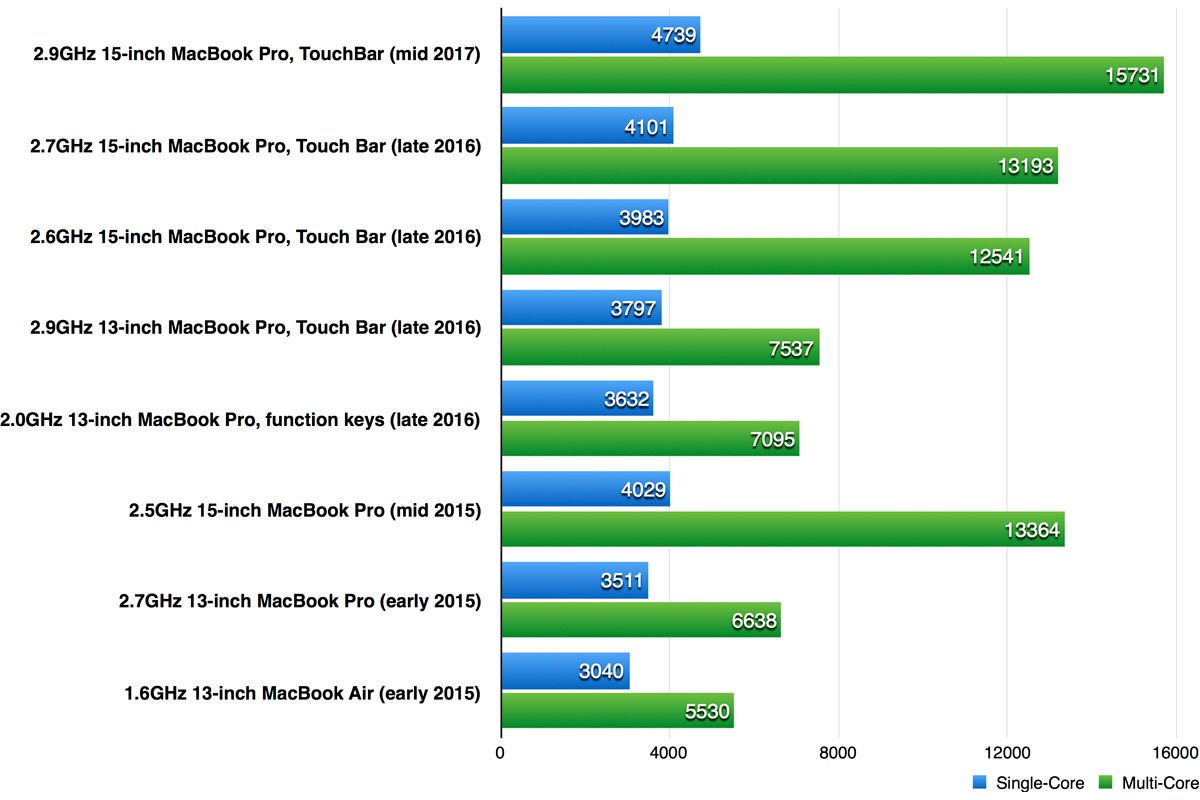
That"s a notable difference (especially when you notice that the 2016 model actually seems to perform worse than the 2015 2.5GHz MacBook Pro which scored 13,364 in the multi-core tests).
In terms of processor there are two big difference between the 13-inch and 15-inch models. The 15-inch models have i7 quad-core processors, while the 13-inch models only i5 dual-core processors.
You might be looking at processor speed and thinking that some of the 13-inch models look better than the 15-inch MacBook Pro, but this is where the difference between quad-core and dual-core comes in.
Because the 15-inch model has four cores the speeds might not look as impressive as the 13-inch MacBook Pro, but remember there are four processors rather than two and that makes a huge difference.
The other major boost comes with the i7 versus i5 processor. We noticed this quite prominantly when we compared the MacBook Pro to the 27-inch iMac, which also features a quad-core processor, but in this case the processor is an i5 variety. (The new iMac is reviewed here: iMac 27-inch (2017) review)
When we ran Geekbench on the 2017 27in 3.4GHz iMac we got a single core score of 4,833 and a multi core score of 15,731, while the MacBook Pro managed 4,739 in single core mode and 15,731 in multi core. That faster multi core result from the MacBook Pro is partly thanks to the i7 chip.
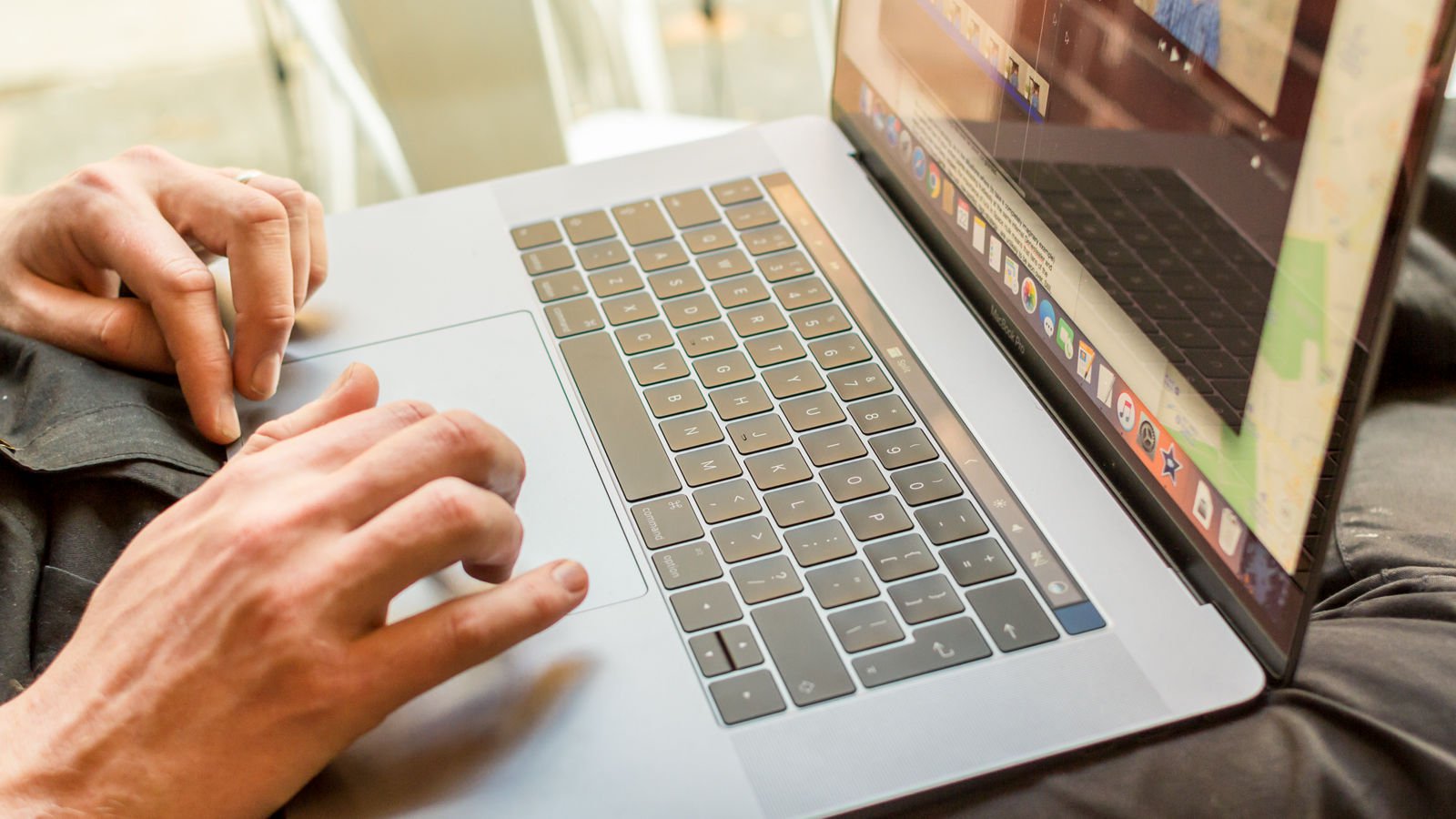
Graphics
With the 2017 MacBook Pro Apple has essentially bought the graphic processors into line with its rivals. The 15in models now offer the Radeon Pro 555 or 560 (replacing the Radeon Pro 455).
That’s not the only graphics related news though. There are some encouraging changes coming in Apple’s upcoming version of macOS.
High Sierra has a focus on graphics, perhaps as a result of Apple’s eagerness to get onboard the VR bandwagon. Of particular interest to anyone working in the creative industries will be the fact that the new OS will support external graphics.
We have some benchmarks here for the 2017 15-inch 2.9GHz MacBook Pro.
Geekbench 4.1 Open CL Intel Integrated Graphics Score | 20,976 |
Geekbench 4.1 Metal Intel Integrated Graphics Score | 19,225 |
Geekbench 4.1 OpenCL Discrete Graphics Score (Radeon) | 42,194 |
Geekbench 4.1 Metal Discrete Graphics Score (Radeon) | 26,416 |
Cinebench OpenGL(fps) | 87.08 |
BlackMagic Write (MBps) | 1,951.14 |
BlackMagic Read (MBps) | 2,397.08 |
Looking specifically at the OpenCL (Radeon) test and the Open CL Cinebench tests gives us some insight into the improvements in terms of the graphics card in comparison to previous models of the MacBook Pro:
Geekbench 4 OpenCL (Radeon)
We also ran a pair of graphics benchmarks to test the speed of the discrete graphics card. In the Geekbench 4 OpenCL test, the 4GB Radeon Pro 560 in the new 2.9GHz MacBook Pro saw a similar score to the 2GB Radeon Pro 450 in the 2016 2.6GHz 15-inch MacBook Pro.
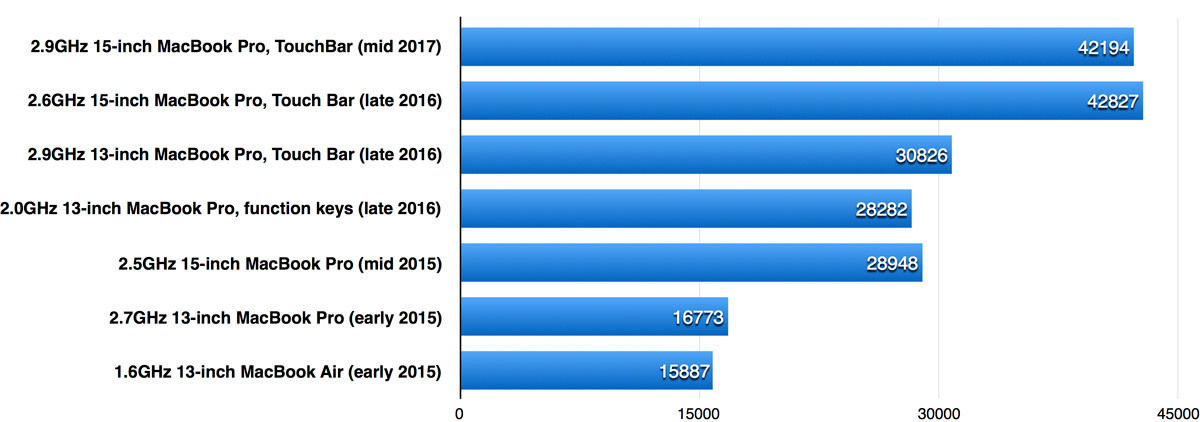
Cinebench OpenGL (fps)
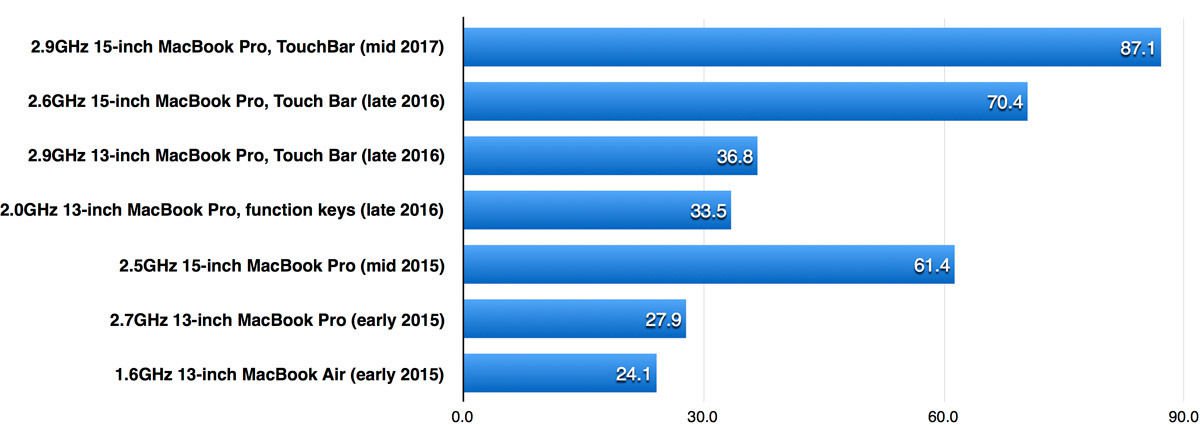
In terms of frames per second, the 2.9GHz MacBook Pro score was 14 per cent better at 87.1 frames per second, that of the 2016 2.6GHz 15-inch MacBook Pro. These are impressive results.
In addition, the Unigine Valley Benchmark 1.0 software gave a result of 18.9fps when in Extreme HD setting, the highest possible rendering rate, and scored overall 789.
Similarly, we ran the AJA System Test benchmark at maximum performance and largest resolution setting (5K RED), which is a 4GB test file. Results showed the MacBook Pro with a write speed of 2054MB/s and read speed of 2574MB/s.
Touch Bar
Despite it growing on us as we use it, it still remains disappointing that Apple has focused on the Touch Bar to differentiate this model of Pro for the second year running.
It is becoming clear that Apple doesn’t intend the MacBook Pro to ever become a touchscreen device and that the Touch Bar is the compromise – and herein lies the problem. On a machine that has only USB-C ports, compromise may have gone a little too far for some users now that they no longer have a normal function key row.
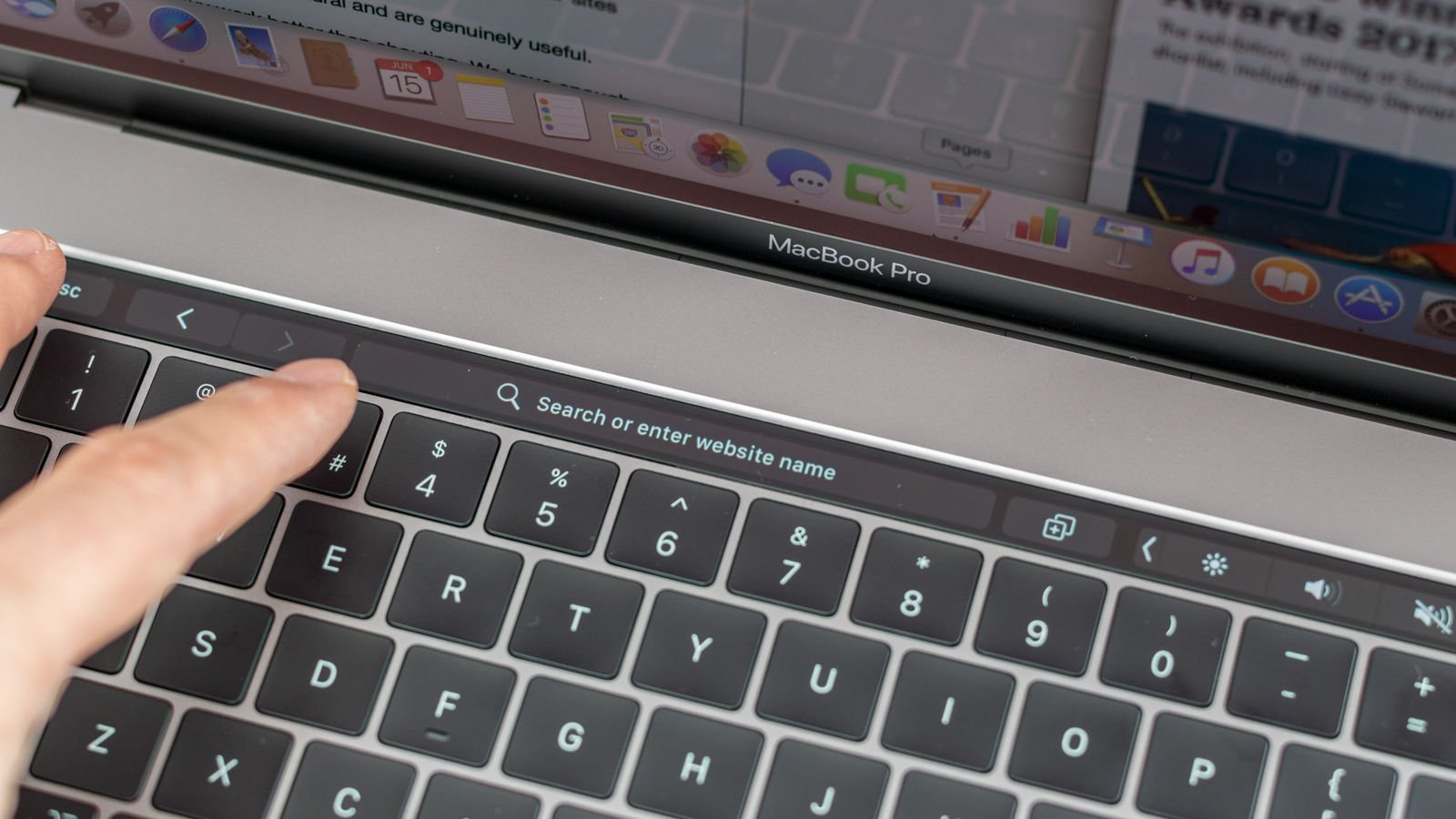
The Touch Bar isn’t completely pointless though. Along with Touch ID capabilities, there is integration with a number of Apple apps, such as Safari, which gains forward and backwards buttons, or Mail that gains auto complete suggestions.
What really matters to pro users though are apps like Photoshop, and Adobe is working on integrating Touch Bar controls into it. You can already use the MacBook Pro Touch Bar in Photoshop, but the features are currently only in Preview (e.g. beta). Hopefully macOS High Sierra will bring added functionality. Read about what you can do with the Touch Bar here.
There’s not a non-Touch Bar version of the 2017 15-inch Pro. We wouldn’t be surprised if Apple introduces one though, as users might prefer it not only for familiarity but for the massive cost saving.
Ports (or lack thereof)
One other thing that could be beneficial to pro users is USB-C with Thunderbolt 3. There are four here, and there’s no denying the improved versatility of a port that can cope with charging, data transfer at great speeds and external monitor output. But if all your peripherals are USB-A or you use HDMI and an Ethernet cable, you’re going to be swimming in dongles. Expensive dongles.
Apple’s solution to this problem is still selling the old 2015 15-inch MacBook Pro, which offers the USB-A slot.
That model is also the only choice for business users who would prefer a 15-inch model but don’t require such high-specs, or want to pay the high price for the new 15-inch MacBook Pro.
This is basically the issue we have with the MacBook Pro: if you want a 15-inch screen you will be spending a lot of money on specs you don’t really need. Or you will be buying a model that’s two years old for at least £450 less.
Software
The machine runs macOS Sierra 10.12.5 out the box, and it is a nicely refined version of Apple’s longstanding Mac operating system. If you’re used to El Capitan then not much has changed but you do get Siri, if you don’t mind talking to a computer.
It integrates well, much like Apple Pay and the Touch ID reader. Quickly paying for items on supported browser websites is a nerdy delight, even though we’ve all done it on our phones by now in apps. Unlocking the computer with biometrics for the first time on a MacBook adds a welcome layer of security.
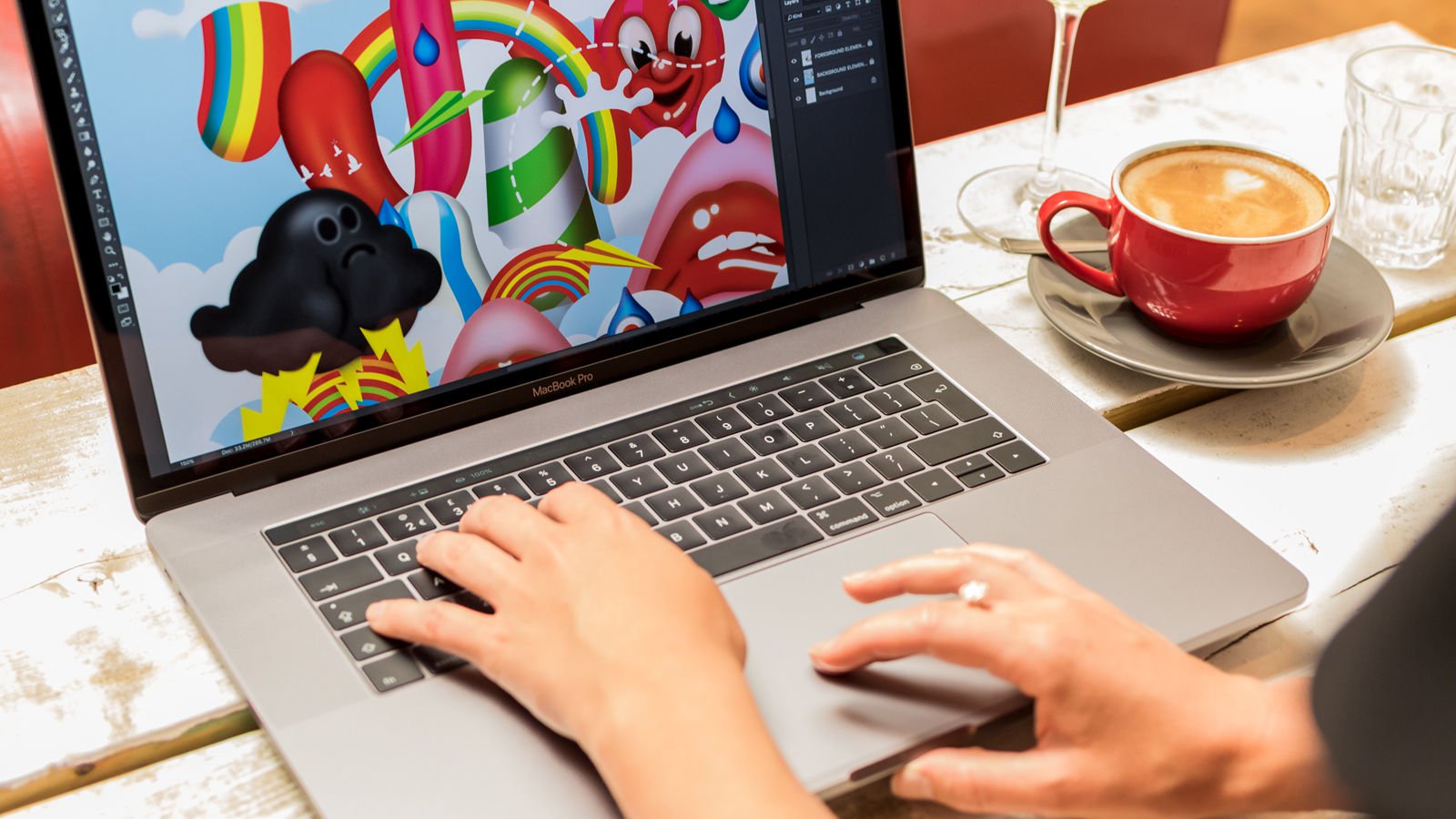
Buying advice
If you bought a new MacBook Pro last October you might be a tiny bit miffed. After all, your machine has just been surpassed within months. Does it really matter though? Probably not because chances are you aren’t a creative professional who needs the best processor and graphics card as well as a ton of RAM. And if you are, we’ll maybe you are holding out for the hoped for MacBook Pro with 32GB RAM.
The MacBook Pro is for a demanding user who needs a decent amount of power. If all you do with your Mac is surf the web and open emails then probably a MacBook or MacBook Air will suffice (although the MacBook Air hasn’t had a significant update in a while).
If it’s the 15-inch screen that’s attracting you perhaps a 13-inch MacBook Pro, or other Mac laptop paired with a bigger display would do the job just as well.
Perhaps it’s portability you need. The MacBook Pro isn’t the lightest laptop Apple makes (that’ll be the MacBook) but it is a lot lighter than it was back in 2015. And if you were thinking of buying the older 2015 model that’s still on sale - that’s the £1,899/$1,999 15-inch model with a 2.2GHz Broadwell processor, bear in mind that it’s quite a bit heavier.
With all that in mind though, if you want a bigger screen and would benefit from a discrete graphics card, rather than one of the integrated ones (which wouldn’t be as good for things like games and creative work), then the 15-inch MacBook Pro is a great choice. We just wish it wasn’t so expensive!
No comments:
Post a Comment